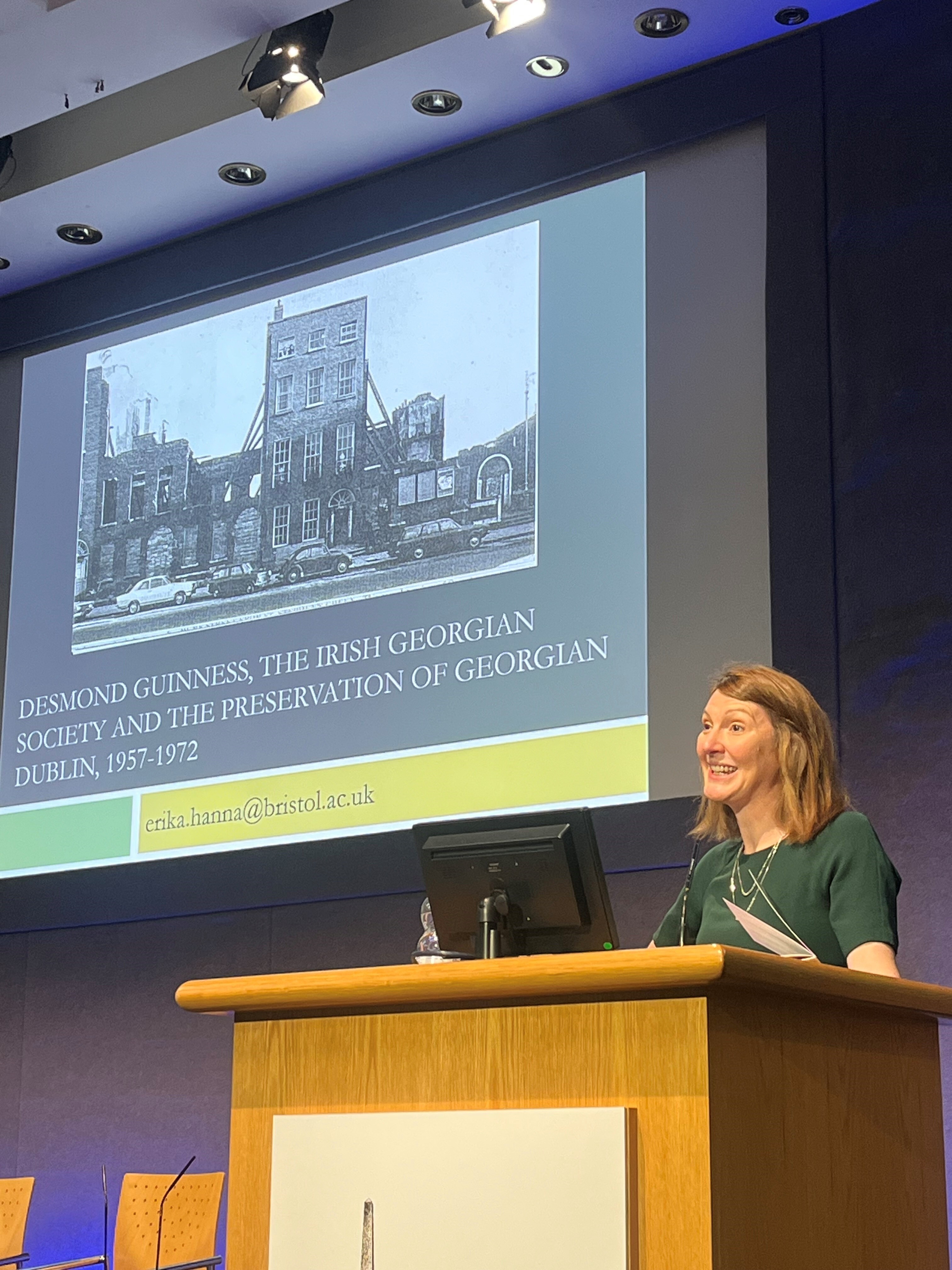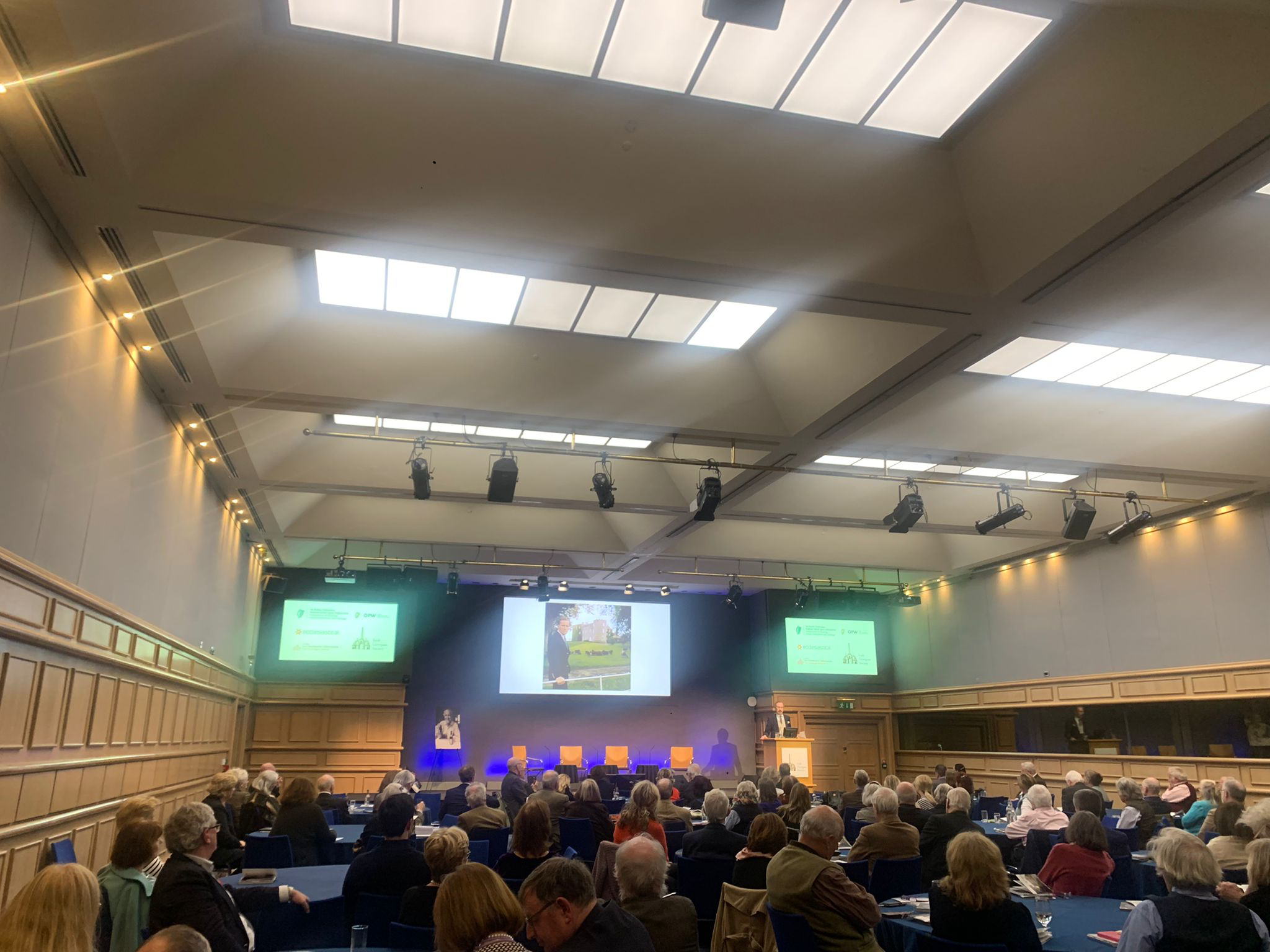Celebrating Desmond Guinness: family, friends & supporters gather in Dublin Castle, 1st Nov 2023
02.11.2023
Posted by IGS

Caption: Celebrating Desmond Guinness convenor, Robert O'Byrne with speaker Jerry Hall.
Celebrating Desmond Guinness, Dublin Castle, Wednesday 1st November 2023.
Family, friends, and supporters gathered in Dublin Castle to celebrate and commemorate Desmond Guinness’s legacy in promoting and protecting Ireland’s architecture and allied arts.Celebrating Desmond Guinness was delivered by the Irish Georgian Society, in partnership with the Guinness family and the Office of Public Works, and with the support of the Department of Housing, Local Government and Heritage, The Heritage Council and Ecclesiastical Insurance.
Inspiring papers were delivered on themes that explored Desmond’s work in advocating for the protection of the Irish country house; campaigning to save Georgian Dublin; fostering research and publications on Ireland’s architecture and decorative arts; and his work overseas as an unofficial ambassador for Ireland’s cultural heritage, where he raised vital funds and forged relationships with benefactors in the UK and USA, which continue to this day through the Irish Georgian Society, which he co-founded with his first wife, Mariga Guinness.
The Society wishes to thank all the speakers and chairs for sharing their memories of and tributes to Desmond, as well as their knowledge and expertise of the Irish Georgian architecture and allied arts, which Desmond fought to save. The day was a fitting homage to Desmond’s herculean endeavours and achievements and captured and reflected the wit and dynamism, magnetism and aplomb with which he accomplished them.

Sir David Davies, President, Irish Georgian Society opening the Celebrating Desmond Guinness.

Rosemary Collier, Head of Heritage & Capital Works Delivery, Asst. Secretary General, OPW welcoming delegates to Dublin Castle.

Dr Edward McParland, (Chair), MRIA, Fellow emeritus of Trinity College Dublin chairing the morning session.

Sir Humphry Wakefield Bt., Friend of Hon Desmond Guinness delivering his paper, Fleeting Glimpses of a Shining Dragonfly: A Life of Constructive Achievement from Childhood, Oxford, Ireland and America.

Dr Erika Hanna, Assoc. Professor, Modern History, University of Bristol delivering her paper, Desmond Guinness, the Irish Georgian Society and the Preservation of Georgian Dublin, 1957-1972.

Dr Conor Lucey (Chair of the afternoon session), Assoc. Professor, School of Art History and Cultural Policy, UCD, member of the board of the Castletown Foundation and the Irish Georgian Society delivering the paper Bulletin, Journal and Prize: a Legacy in Scholarship by Dr Christine Casey, Professor, Architectural History, Trinity College Dublin and Castletown foundation board member.

Mary Heffernan, Director of National Monuments, OPW chairing the second morning session.

Máirtín D’Alton, Architect, Heritage Services - Conservation, OPW delivering his presentation entitled The Legacy of Desmond Guinness: Recent Works Uncover the Building History of Damer House which included a slide showing him at a reception where he was awarded the Desmond Guinness Scholarship by the Hon. Desmond Guinness.

Christopher Moore, former Irish Georgian Society and Castletown Foundation board member and Chair of the latter, 2013 -2018 delivering his paper, Castletown & Doneraile: from the brink, which included previously unseen images from the Guinness family's private photographic albums.

Desmond's friend, the cultural icon, Jerry Hall treating us to extracts from his Leixlip diaries.

Dr John Goodall, Architectural Editor of Country Life Magazine delivering his paper, Country Life and the Irish Country House.

Jeremy G.D. Musson, LLB (Hons), MPhil, FSA deliver his paper entitled, ‘Through Desmond’s Eyes:’ Architectural History and Heritage Advocacy for a World Audience, which contained many personal reminiscences about his times spent with Desmond at Leixlip Castle and other Irish historic houses.

Donough Cahill, Executive Director, Irish Georgian Society chairing the afternoon session where he took the opportunity to thank all members of the Irish Georgian Society for their continuing support of the society which Desmond founded in 1958, while encouraging those not yet members to join today!

Dr Ciarán Reilly, Asst. Director, Centre for the Study of Historic Irish Houses & Estates, Maynooth University delivering his paper, ‘The Demesne Walls are Coming Down’ Figuratively Speaking: Opening Up the Country House, 1958-1978'.

Marion Cashman, former IGS board member and editor of The Irish Georgian Society: A Celebration (2008), sharing her paper, Memories of Desmond Guinness: 50 Years Campaigning for the Conservation of Ireland’s Architectural Heritage, which provided a wonderful account that spanned her first encounters with Desmond and the Society volunteering at Castletown in the 1970s through to her and her husband Adrian Masterson's work in commissioning the film, 'Saving Our Heritage, The Irish Georgian Society' which included in depth interviews with Desmond.

Robert O’Byrne, former IGS Vice-President and author of The Irish Georgian Society: A Celebration (2008) sharing his paper, Desmond Guinness in America.

Patrick Guinness, son of Desmond Guinness, former President of the Irish Georgian Society making the concluding remarks and thanking all gathered for their participation.

Robert O'Byrne, convenor of Celebrating Desmond Guinness addressing the audience of family, friends and supporters gathered in Dublin Castle




